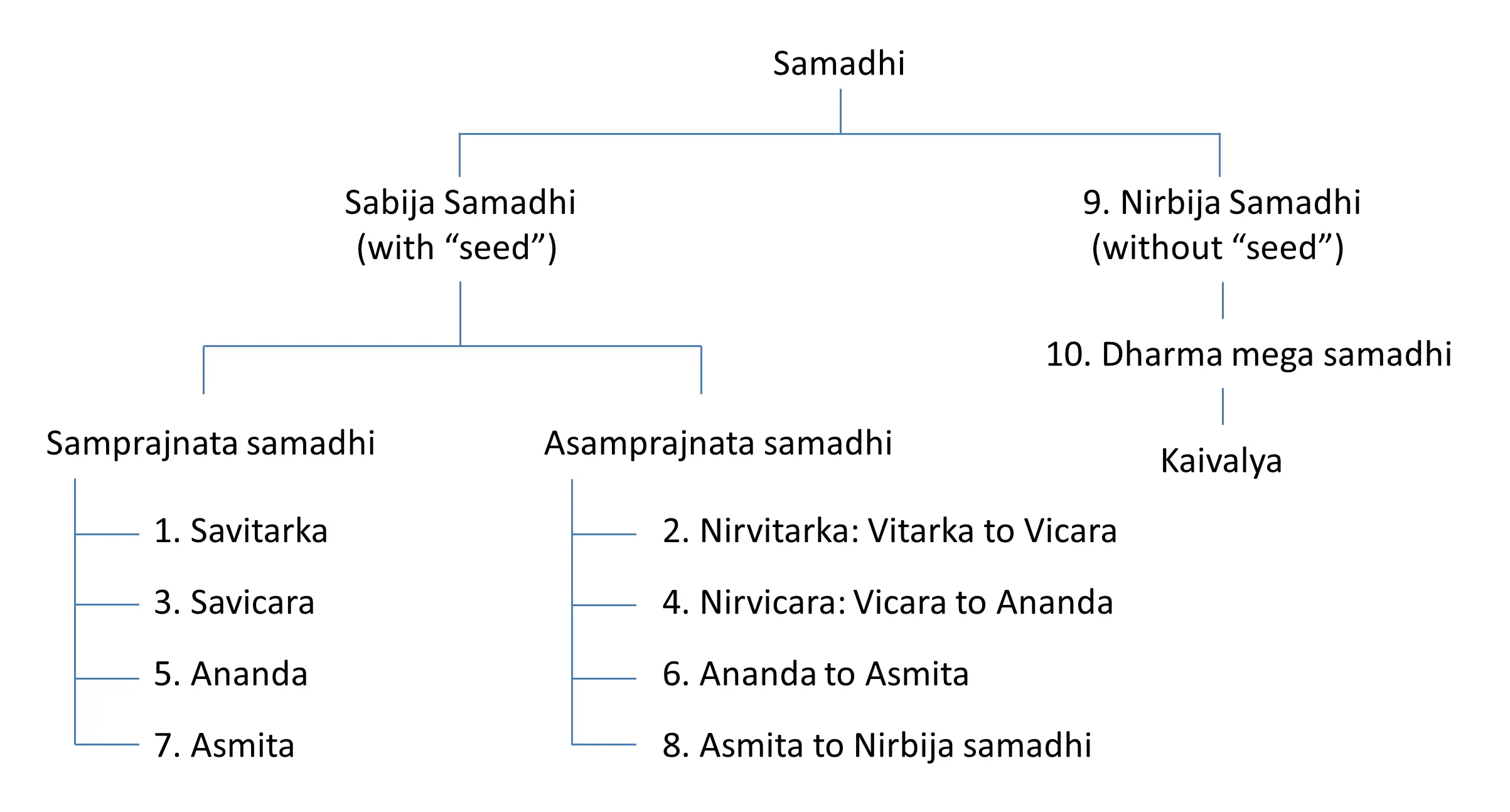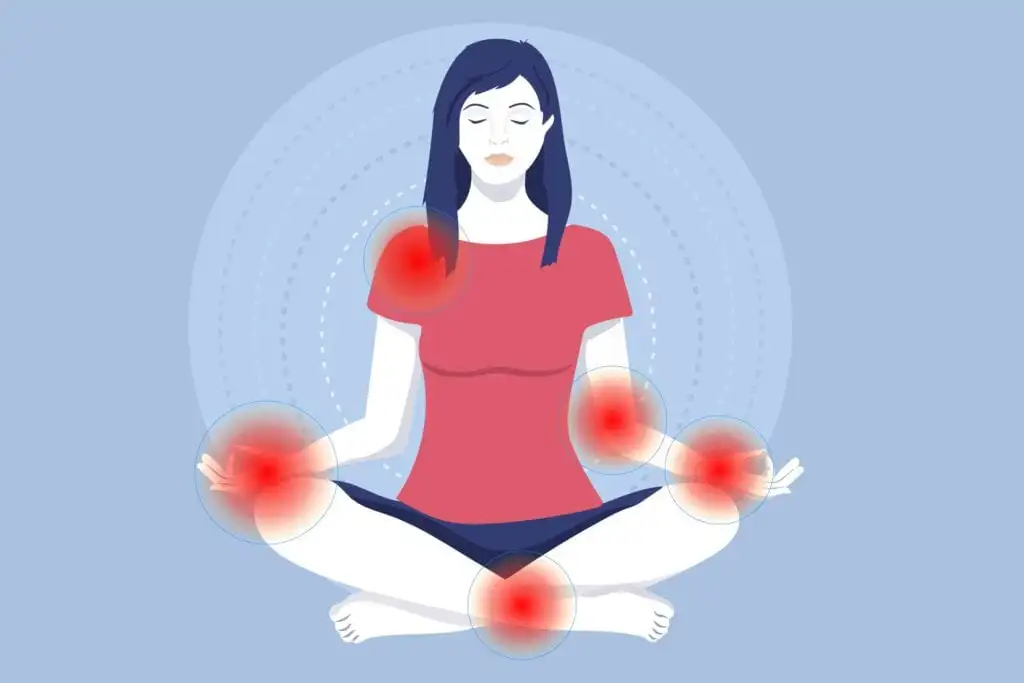Do you ever feel like your meditation practice isn’t going anywhere? You sit down to meditate, but nothing special happens and you might even get frustrated. You are not alone – many people struggle to reach a deep state of meditation samadhi, where you feel really peaceful and clear.
Step into the world of Samadhi, the shining gem at the end of yoga’s spiritual journey. Samadhi is like reaching the very end of a map where amazing things happen. It’s where you find deep happiness and a brand-new understanding of yourself.
In this blog post we will make it simple. We will explain what samadhi is, and 8 Types of Samadhi, and give you practical tips to help you experience it in your meditation practice
Contents
What is Samadhi in Yoga?
Samadhi is an important concept in yoga, especially in a book called Patanjali’s Yoga Sutras. In this book, Samadhi is the last part of yoga, like the ultimate goal. Before reaching Samadhi, there are other steps in yoga, like being good to others (Yamas), following personal rules (Niyamas), doing yoga poses (Asana), controlling your breathing (Pranayama), focusing your mind (Dharana), and meditating (Dhyana). Samadhi yoga is like the grand finale where everything comes together, and you feel a deep sense of connection and peace. It’s about reaching a state where you feel completely absorbed and at one with everything around you.
Originating from ancient Sanskrit, the word “Samadhi” is derived from the roots “sam,” meaning “together” or “integrated,” and “adhi,” meaning “to place” or “establish.” Thus, Samadhi can be understood as the integration or establishment of the individual consciousness with the universal consciousness.
8 Types of Samadhi

- Vitarka Samadhi
- Vichara Samadhi
- Ananda Samadhi
- Asmita Samadhi
- Nirvikalpa Samadhi
- Savikalpa Samadhi
- Sahaja Samadhi
- Turiya Samadhi
Vitarka Samadhi
Vitarka Samadhi is like when you are focused on something, maybe playing a game or doing homework. It is when your mind is fully concentrated on one thing, without any distractions. You’re completely absorbed in what you’re doing, and your attention doesn’t wander away. It’s like being in the zone, where you are fully present and engaged in the task at hand. That’s what Vitarka Samadhi is all about – deep concentration and focus.In addition to Vitarka Samadhi, there are other stages of meditation, including Dhyana, Dharana, and 4 types of pratyahara, each with its own unique characteristics and benefits.
Vichara Samadhi
Vichara Samadhi is when your mind becomes really clear and focused but in a calm and relaxed way. It’s like when you’re thinking deeply about something, and your mind feels very peaceful and steady. You’re not trying hard to concentrate, but your thoughts flow smoothly and you feel very aware and present in the moment. It’s a state where you can reflect deeply on things without getting distracted by other thoughts or worries. So, Vichara Samadhi is all about having a calm and clear mind while you think deeply about something important to you.
Ananda Samadhi
Ananda Samadhi is when you feel an overwhelming sense of happiness and joy during meditation. It’s like being filled with a deep and profound sense of contentment and bliss. In this state, you’re completely absorbed in the present moment, and you feel a deep connection to everything around you. It’s a very peaceful and uplifting experience, where you feel truly alive and in harmony with the universe. Ananda Samadhi is all about experiencing pure happiness and joy from within, without needing anything external to make you feel that way.
Asmita Samadhi
Asmita Samadhi is when you feel a sense of oneness and unity with everything around you. It’s like feeling connected to the universe in a very deep and profound way. In this state, you no longer feel separate from the world or from other people. Instead, you feel a sense of unity and interconnectedness with all of creation. It’s a very powerful and transformative experience, where you realize that you are not just an individual, but part of something much greater than yourself. Asmita Samadhi is all about experiencing a deep sense of unity and connection with the universe.
Nirvikalpa Samadhi
Nirvikalpa Samadhi is like being in a state of complete stillness and peace. It’s when your mind becomes totally quiet, and there are no thoughts or distractions at all. It’s a very deep and profound experience, where you feel completely at one with everything around you. In this state, there is no sense of time or space, and you feel a deep sense of inner peace and contentment. It’s like being in a state of pure awareness, where you are fully present in the moment and nothing else matters. Nirvikalpa Samadhi is all about experiencing a deep sense of calm and tranquility that is beyond words.
Savikalpa Samadhi
Savikalpa Samadhi is a state of meditation where you’re still aware of your surroundings, but your mind is deeply absorbed in a single object or thought. It’s like being in a very focused and concentrated state, where you’re fully engaged in your meditation practice. In Savikalpa Samadhi, you may still have some awareness of your individuality and the world around you, but your attention is primarily directed towards your chosen focus. It’s a stage where you’re starting to experience deeper levels of concentration and absorption, but you’re not completely detached from the external world yet.
Sahaja Samadhi
Sahaja Samadhi is like being in a natural and effortless state of meditation. It’s when the calm and clarity you experience during meditation becomes a part of your everyday life. In Sahaja Samadhi, you don’t have to make any special effort to meditate because your mind naturally remains peaceful and focused. It’s a state of continuous awareness and presence, where you feel deeply connected to your inner self and to the world around you. Sahaja Samadhi is about finding a sense of harmony and balance that permeates every aspect of your life, making it a seamless and joyful experience.
Turiya Samadhi
Turiya Samadhi yoga is the highest state of consciousness in yoga philosophy. It’s a state of profound transcendence, where you go beyond the limitations of ordinary waking, dreaming, and deep sleep states. In Turiya Samadhi, you experience pure awareness and bliss that is beyond any mental activity or experience. It’s like being completely absorbed in the divine or ultimate reality, where there is no sense of individual self or separation. Turiya Samadhi represents the ultimate goal of spiritual practice, where you realize your true nature as infinite and eternal consciousness.
Benefits of Samadhi

- Heightened Awareness: Experiencing Samadhi yoga expands one’s awareness beyond the limitations of the ego. It allows individuals to perceive reality more clearly and deeply, leading to greater insights and understanding of oneself and the world.
- Blissful States: Samadhi is often associated with feelings of profound bliss and ecstasy. By transcending the ego and connecting with the universal consciousness, individuals can experience states of unparalleled joy and happiness.
- Self-Realization: Samadhi is a gateway to self-realization and spiritual awakening. Through deep meditation and absorption, individuals can come to recognize their true nature as pure consciousness, beyond the confines of the ego and the material world.
- Improved Health: Research has shown that regular meditation, including practices leading to Samadhi yoga can have numerous health benefits, such as reduced blood pressure, improved immune function, and enhanced overall well-being.
- Connection to the Divine: Samadhi yoga allows individuals to experience a profound connection to the divine or higher power. By transcending the limited sense of self, individuals can experience a sense of oneness with the universe and feel deeply connected to something greater than themselves.
Techniques of Samadhi Yoga

- Body Scan Meditation: Body scan meditation systematically brings awareness to different body parts, from head to toe. This helps to relax the body, release tension, and cultivate mindfulness.
- Mindfulness Meditation: Mindfulness meditation involves observing the present moment without judgment. This includes observing bodily sensations, thoughts, emotions, and external stimuli. Mindfulness meditation helps to cultivate present-moment awareness, acceptance, and inner peace.
- Guided Meditation: Guided meditation involves following the instructions of a teacher or recorded audio to lead you through a meditation practice. This can be helpful for beginners or those who prefer guidance during meditation.
- Yoga Asanas (Postures): Practicing yoga postures helps to prepare the body for meditation by releasing tension, increasing flexibility, and promoting relaxation. The physical practice of yoga can also help to quiet the mind and cultivate mindfulness.
- Prayer and Devotion: Engaging in prayers, chanting, or devotional practices can help to cultivate a sense of connection to the divine and deepen one’s spiritual practice.
- Silent Meditation: Silent meditation involves sitting quietly with eyes closed and focusing inward. This allows for the observation of thoughts, emotions, and sensations without attachment or judgment.
Conclusion
In conclusion, as we wrap up our exploration of What is Samadhi in Yoga and the 8 Types of Samadhi, we have gained insights into the profound practice of meditation and its potential to transform our lives. By understanding the essence of Samadhi and delving into its various manifestations, we’ve embarked on a journey of self-discovery and inner peace.
Looking ahead, our journey continues as we delve deeper into practical techniques to integrate Samadhi yoga into your daily life. We’ll explore simple yet powerful practices such as mindfulness, guided meditation, and yoga postures, all aimed at deepening your connection with the universal consciousness. Additionally, we’ll uncover the myriad benefits of Samadhi yoga, from heightened awareness to enhanced well-being.
